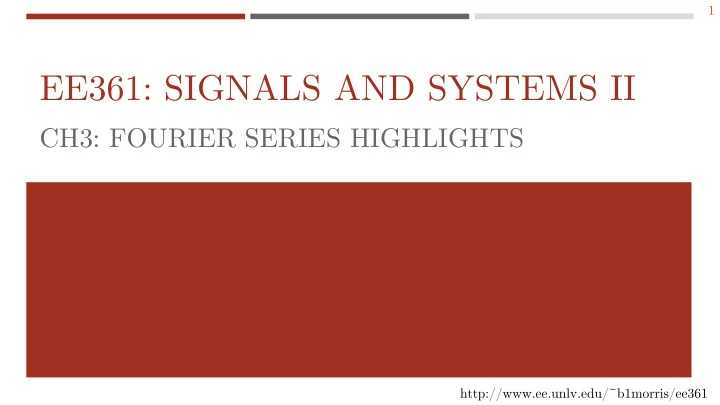

1 EE361: SIGNALS AND SYSTEMS II CH3: FOURIER SERIES HIGHLIGHTS http://www.ee.unlv.edu/~b1morris/ee361
2 FOURIER SERIES OVERVIEW AND MOTIVATION
3 BIG IDEA: TRANSFORM ANALYSIS Make use of properties of LTI system to simplify analysis Represent signals as a linear combination of basic signals with two properties Simple response: easy to characterize LTI system response to basic signal Representation power: the set of basic signals can be use to construct a broad/useful class of signals
4 NORMAL MODES OF VIBRATING STRING When plucking a string, length is divided into integer divisions or harmonics Frequency of each harmonic is an integer multiple of a “fundamental frequency” Also known as the normal modes Any string deflection could be built out of a linear combination of “modes”
5 NORMAL MODES OF VIBRATING STRING When plucking a string, length is divided into integer divisions or harmonics Frequency of each harmonic is an integer multiple of a “fundamental frequency” Also known as the normal modes Any string deflection could be built out of a linear Caution: turn your sound down combination of “modes” https://youtu.be/BSIw5SgUirg
6 FOURIER SERIES 1 SLIDE OVERVIEW Harmonically related period Fourier argued that periodic signals form family signals (like the single period Integer multiple of fundamental from a plucked string) were frequency actually useful 𝜚 𝑙 𝑢 = 𝑓 𝑘𝑙𝜕 0 𝑢 for 𝑙 = 0, ±1, ±2, … Represent complex periodic signals Examples of basic periodic signals Fourier Series is a way to represent a periodic signal as a Sinusoid: 𝑦 𝑢 = 𝑑𝑝𝑡𝜕 0 𝑢 linear combination of harmonics Complex exponential: 𝑦 𝑢 = 𝑓 𝑘𝜕 0 t ∞ 𝑏 𝑙 𝑓 𝑘𝑙𝜕 0 𝑢 𝑦 𝑢 = σ 𝑙=−∞ Fundamental frequency: 𝜕 0 𝑏 𝑙 coefficient gives the contribution of a harmonic (periodic signal of 𝑙 Fundamental period: 𝑈 = 2𝜌 times frequency) 𝜕 0
7 SAWTOOTH EXAMPLE Harmonics: height given by coefficient signal 𝑏 3 𝑏 4 … 𝑏 2 𝑏 1 Animation showing approximation as more harmonics added
8 SQUARE WAVE EXAMPLE Better approximation of square Aligned approximations wave with more coefficients 1 coefficients Animation of FS 2 #𝑏 𝑙 3 4 Note: 𝑇(𝑔) ~ 𝑏 𝑙
9 ARBITRARY EXAMPLES Interactive examples [flash (dated)][html]
10 RESPONSE OF LTI SYSTEMS TO COMPLEX EXPONENTIALS CHAPTER 3.2
11 TRANSFORM ANALYSIS OBJECTIVE Need family of signals 𝑦 𝑙 𝑢 that have 1) simple response and 2) represent a broad (useful) class of signals Family of signals Simple response – every signal in family pass 1. through LTI system with scale change 𝑦 𝑙 (𝑢) ⟶ 𝜇 𝑙 𝑦 𝑙 (𝑢) “Any” signal can be represented as a linear combination of 2. signals in the family ∞ 𝑦 𝑢 = 𝑏 𝑙 𝑦 𝑙 (𝑢) 𝑙=−∞ Results in an output generated by input 𝑦(𝑢) ∞ 𝑦 𝑢 ⟶ 𝑏 𝑙 𝜇 𝑙 𝑦 𝑙 (𝑢) 𝑙=−∞
12 IMPULSE AS BASIC SIGNAL Previously (Ch2), we used shifted and scaled deltas 𝜀 𝑢 − 𝑢 0 ⟹ 𝑦 𝑢 = ∫ 𝑦 𝜐 𝜀 𝑢 − 𝜐 𝑒𝜐 ⟶ 𝑧 𝑢 = ∫ 𝑦 𝜐 ℎ 𝑢 − 𝜐 𝑒𝜐 Thanks to Jean Baptiste Joseph Fourier in the early 1800s we got Fourier analysis Consider signal family of complex exponentials 𝑦 𝑢 = 𝑓 𝑡𝑢 or 𝑦 𝑜 = 𝑨 𝑜 , 𝑡, 𝑨 ∈ ℂ
13 COMPLEX EXPONENTIAL AS EIGENSIGNAL Using the convolution 𝑓 𝑡𝑢 ⟶ 𝐼 𝑡 𝑓 𝑡𝑢 𝑨 𝑜 ⟶ 𝐼 𝑨 𝑨 𝑜 Notice the eigenvalue 𝐼 𝑡 depends on the value of ℎ(𝑢) and 𝑡 Transfer function of LTI system Laplace transform of impulse response
14 TRANSFORM OBJECTIVE Simple response 𝑦 𝑢 = 𝑓 𝑡𝑢 ⟶ 𝑧 𝑢 = 𝐼 𝑡 𝑦 𝑢 Useful representation? 𝑦 𝑢 = σ𝑏 𝑙 𝑓 𝑡 𝑙 𝑢 ⟶ 𝑧 𝑢 = σ𝑏 𝑙 𝐼 𝑡 𝑙 𝑓 𝑡 𝑙 𝑢 Input linear combination of complex exponentials leads to output linear combination of complex exponentials Fourier suggested limiting to subclass of period complex exponentials 𝑓 𝑘𝑙𝜕 0 𝑢 , 𝑙 ∈ ℤ, 𝜕 0 ∈ ℝ 𝑦 𝑢 = σ𝑏 𝑙 𝑓 𝑘𝑙𝜕 0 𝑢 ⟶ 𝑧 𝑢 = σ𝑏 𝑙 𝐼 𝑘𝑙𝜕 0 𝑓 𝑡 𝑙 𝑢 Periodic input leads to periodic output. 𝐼 𝑘𝜕 = 𝐼 𝑡 ȁ 𝑡=𝑘𝜕 is the frequency response of the system
Recommend
More recommend